How does storage affect freshness when you buy kratom powder?
Proper storage conditions directly determine how long kratom powder maintains its potency and quality after purchase. Kratom’s alkaloid compounds are sensitive to light, heat, moisture, and oxygen. Storing happy go leafy kratom powder correctly helps retain its qualities for long-term personal use. Identifying these degradation factors helps preserve your investment.
Light exposure damage
Direct sunlight and artificial UV light break down kratom’s active alkaloids through photodegradation. This process begins immediately upon exposure and accelerates in bright conditions. The mitragynine and 7-hydroxy mitragynine compounds that create kratom’s effects are particularly susceptible to light damage, with prolonged exposure causing significant potency loss within weeks. Storage in opaque containers provides the best protection against light-induced degradation. Dark glass jars, solid plastic containers, or foil-lined packages block harmful wavelengths that damage alkaloids. Even indirect light from windows causes gradual deterioration, making cabinet storage preferable to countertop placement. The packaging you receive kratom in may not provide adequate light protection for long-term storage, making container transfer essential for maintaining freshness.
Moisture control measures
- Desiccant packets – Food-grade silica gel absorbs excess humidity while maintaining stable internal conditions
- Vacuum-sealed storage – Eliminates both moisture and oxygen exposure simultaneously
- Humidity monitoring – Keep storage areas below 60% relative humidity to prevent microbial growth
- Proper sealing – Ensure containers create airtight barriers against environmental moisture
Humidity represents the most serious threat to kratom powder freshness. Moisture encourages bacterial and mold growth while facilitating alkaloid degradation through hydrolysis reactions. Kratom powder should maintain moisture below 10% to prevent microbial contamination and preserve potency. High humidity environments like bathrooms or kitchens create particularly problematic storage conditions.
Temperature stability requirements
Heat accelerates the breakdown of kratom’s alkaloid compounds through increased molecular activity and chemical reactions. Storage temperatures above 75°F begin causing noticeable degradation, while temperatures exceeding 85°F create rapid potency loss. Refrigerator storage maintains consistent cool temperatures but introduces condensation risks when containers warm to room temperature. Room temperature storage in climate-controlled environments provides the optimal balance between stability and convenience. Avoid storage areas that experience temperature fluctuations, like garages, attics, or near heating vents. Basements often offer naturally cool, stable environments ideal for kratom storage. The key involves maintaining consistent temperatures rather than seeking the coldest possible conditions, as temperature swings create more problems than moderate but stable warmth.
Container selection guidelines
- Glass jars with tight-fitting lids provide excellent moisture and oxygen barriers while remaining chemically inert.
- Food-grade plastic containers offer lightweight alternatives that deliver good protection when properly sealed.
- Vacuum-sealed bags remove oxygen exposure while creating compact storage solutions for those with limited space.
- Mylar pouches reflect light while providing moisture barriers and are often used inside other containers for double protection.
- Metal tins block light effectively but may require liner bags to prevent moisture infiltration. The container material significantly impacts preservation effectiveness, with proper sealing being equally crucial as material selection for maintaining kratom freshness.
Oxygen exposure prevention
- Nitrogen flushing – Removes oxygen from containers before sealing to create an inert storage atmosphere
- Oxygen absorber packets – Food-grade packets eliminate residual oxygen after container sealing
- Minimal air space – Fill containers appropriately to reduce oxygen volume in contact with powder
- Quick handling – Limit exposure time when accessing stored kratom to minimize oxidation
Oxygen slowly oxidizes kratom’s alkaloids, causing gradual potency reduction and flavor changes. This oxidation occurs continuously when powder remains exposed to air, creating cumulative degradation over time. Minimizing air exposure through proper container selection and handling techniques preserves freshness significantly longer than casual storage methods.


